Last month, educators came together from across the province and beyond to participate in a two-day Physical and Health Education (PE and HE) Conference.
The event—a partnership between PHE Manitoba and SJASD—featured the latest research and best practices in physical education. Attendees descended on Collège Sturgeon Heights Collegiate and other satellite SJASD schools to learn about everything from inclusive physical education practices, to the circus arts, to outdoor education, to working with emotions in PE, to how to start a fitness club.
Conference Organizer and SJASD Physical Education and Health Education Coordinator J.J. Ross says the workshops were generally a mix of SEE sessions focused on classroom learning or observing instruction, and DO sessions where attendees could try the activities themselves.
“It was a great opportunity to showcase the great work of our physical educators while contributing to advancements in our field," he says. “I really appreciate all the teachers, staff and students that volunteered their time, their facilities and their expertise to take part in this important event."
Inclusive Practices: It's SENSE-ational
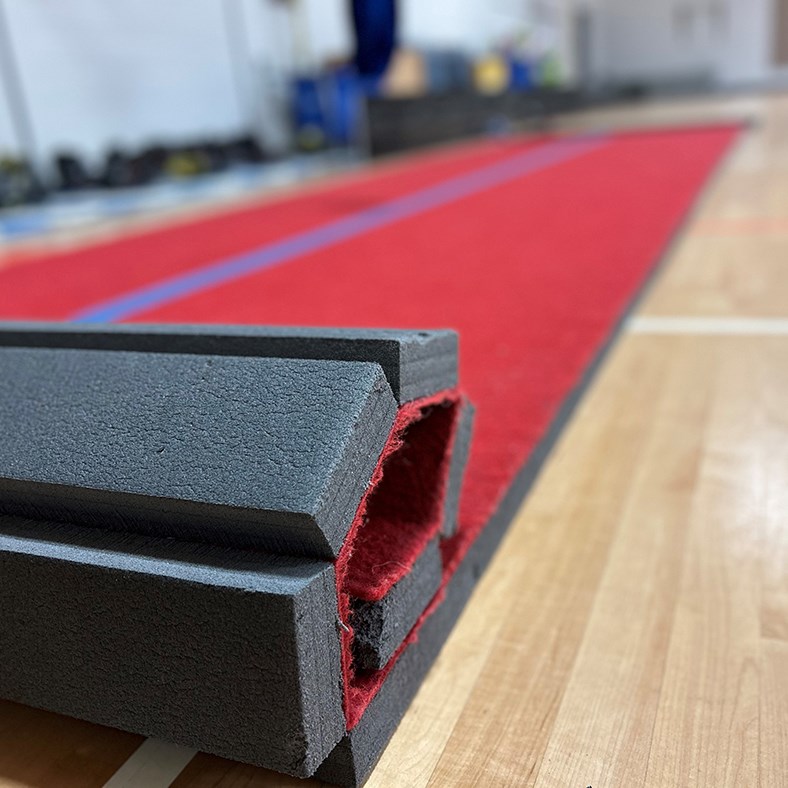
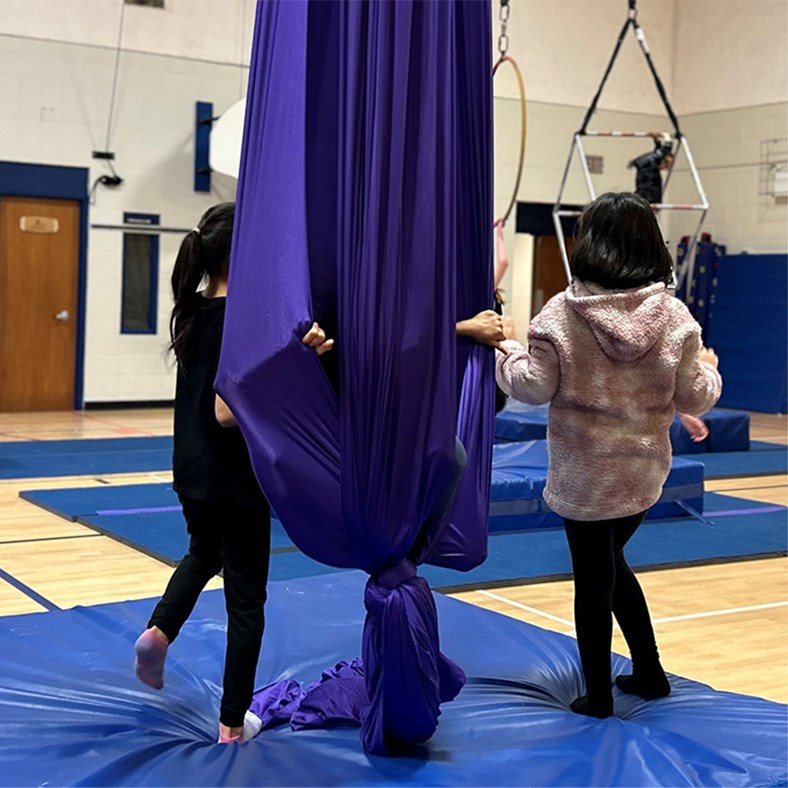
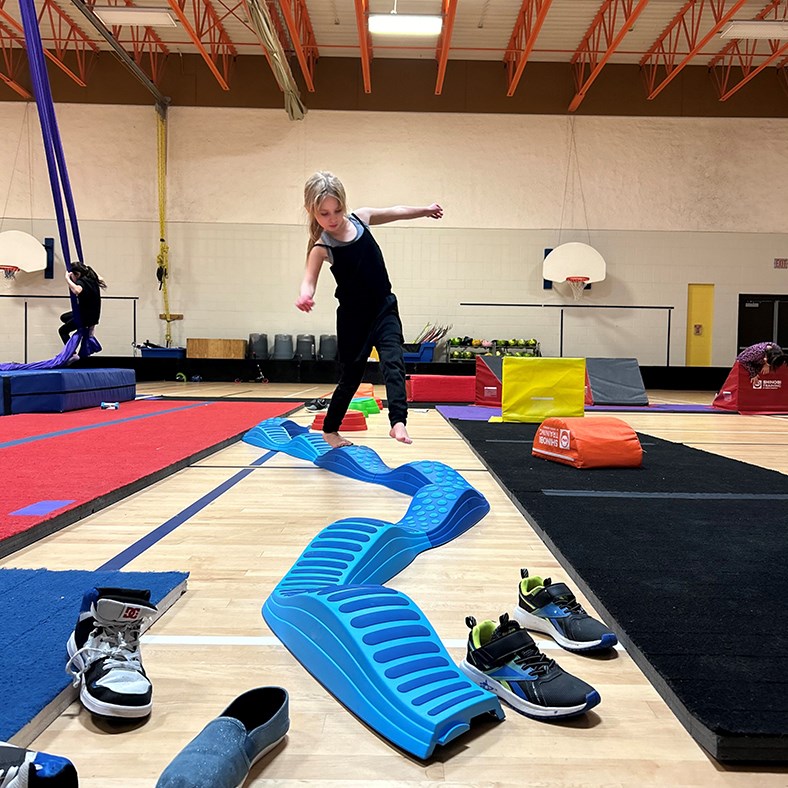
Pictured (from left to right): A perforated mat; One student wraps themselves in an aerial silk; Student enjoys texture-based parkour circuit.
At a SEE session at Lakewood School, attendees watched as teacher Jeff Spiers led an inclusive physical education class incorporating sensory objects that appeal to students with neurodiverse needs such as autism.
It's part of the Division's work with University of Manitoba Physical Therapy professor Dean Kriellaars on the SENSE-ational Schools project. Five SJASD schools and one daycare in the Division are currently taking part. The initiative has been running for the last 2.5 years.
Items like hanging circus silks can appeal to students with autism because they can wrap themselves in the fabric like a blanket. This places pressure on their bodies, which helps to reduce stress and anxiety. A wooden ramp works in the same way, allowing students to slide quickly down the ramp while putting deep pressure on their bodies. Using circus equipment to swing or spin can also help calm nerves, while rolling in a monkey barrel is fun for everyone, but also appeals to neurodiverse students that may feel more comfortable in an enclosed space.
Other types of sensory objects create interest for neuro-diverse students, keeping them engaged and participating in active movement. For example, neuro-diverse students often enjoy helping teachers roll out or roll up perforated mats. They also respond well to parkour-like objects that have a shape and/or texture.
“They like it, but other kids do too," explains Dean. Among the Grade 4 students participating in the SEE session, one child had sensory needs and an Educational Assistant available to support and address behaviour, but no intervention was necessary. “You can't identify [the student] here, which is what we want," he explains.
Reducing gym noise can be another quick way to address sensory overstimulation. Swapping out loud music for quiet, calming tunes can put everyone at ease. At the Lakewood gym, educators have modified ride-on toys like plasma cars with rubber tires to reduce road noise, helping everyone relax in the process.
“The social skills of these kids dramatically increases because they can manage," says Dean.
SENSE-ational Schools received the largest single grant to date ($125,000) from the province's Teachers' Idea Fund (2021–22).
The Circus Arts: Not Just Clowning Around
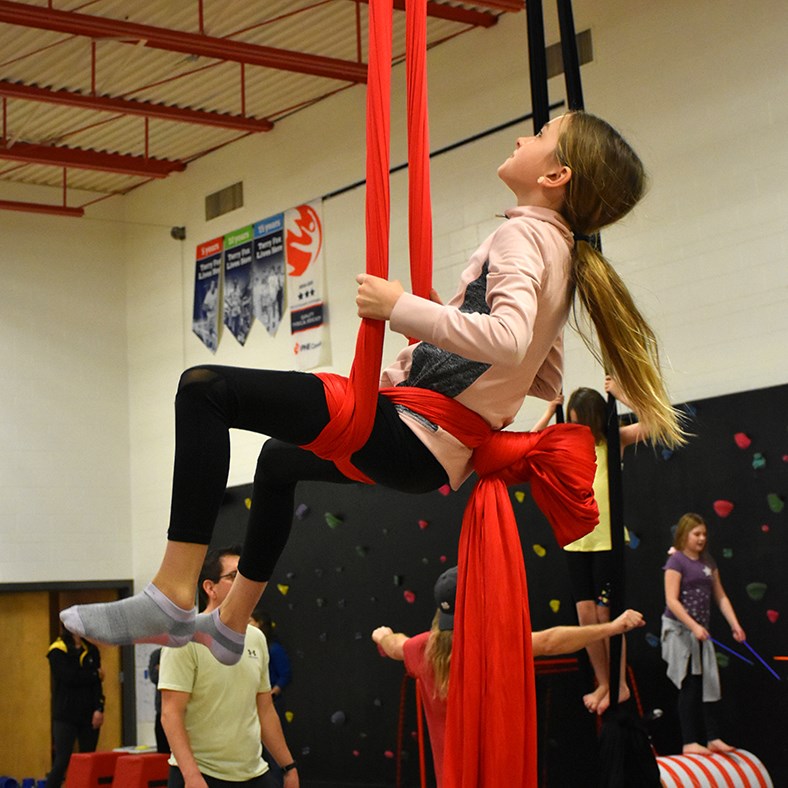
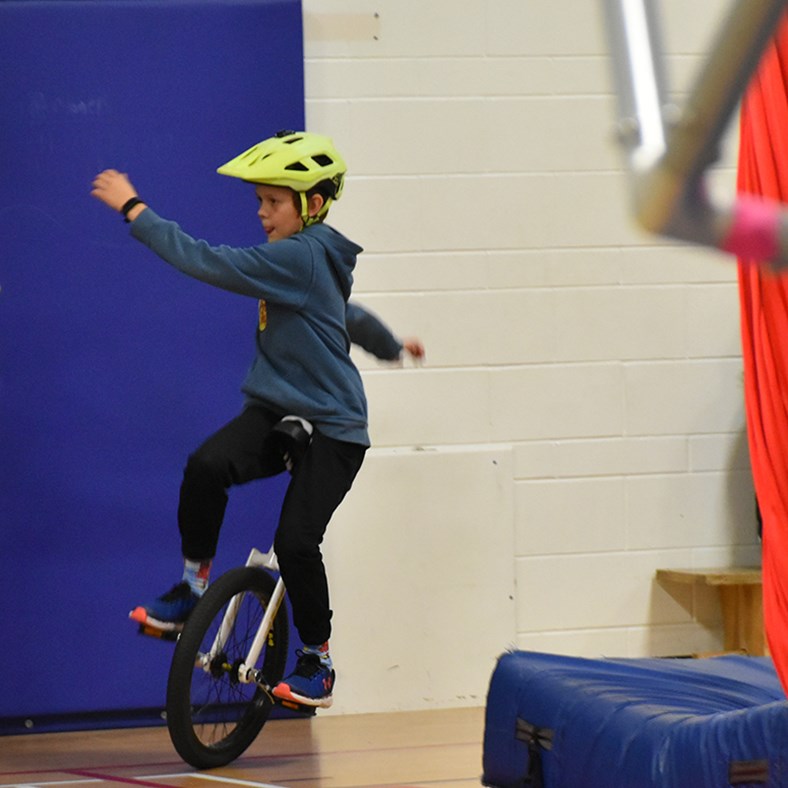
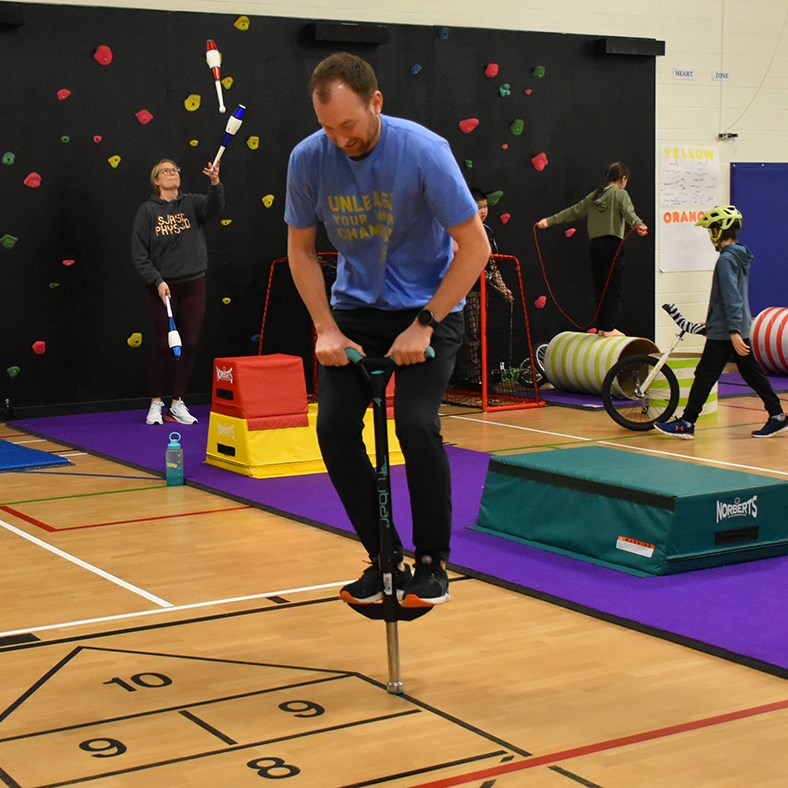
Pictured (from left to right): École Robert Browning student Lyla C. demonstrates the silks; Student unicycler circles the gym; Seven Oaks School Division attendee tries the pogo stick, while Michelle Parnell from Athlone School juggles in the background.
Over at Heritage School at a DO session, SJASD educators Dan Sarahs (Heritage School), Bryan Vermeylen (École Robert Browning), and Dustin Vosper (Brooklands School) introduced teachers to the tools of the circus arts, including aerial objects like the hoop, cube, trapeze, and silks, and ground-based tools like the pogo stick, stilts, unicycle, flower sticks and juggling pins.
Bryan Vermeylen was one of the first educators from SJASD to travel to Montreal to obtain his certification in the circus arts. He's been delivering circus to his students for about eight years.
Michelle Parnell, a physical educator from Athlone School, started teaching circus in 2022 and watched Bryan's canon ball circus warm-up demonstrations with interest.
“We just started an after-school circus program and it's a hit," she says. “We have one silk but we're in the process of getting another silk and that is going to be a gamechanger because of the number of kids you can get on the apparatus."
Graham Forsyth is a K to 8 physical educator from Seven Oaks School Division. He points out that a lot of things need to happen to get a circus program off the ground, but he's interested in incorporating some basic tools as a start.
Craig Gawrluk, a physical educator from Seven Oaks School Division agrees, and would like to bring in some elements such as pogo sticks, flower sticks and mats into the gym.
Student demonstrator Lyla C. has been learning circus at École Robert Browning for two years and loves it. “I like doing circus at school," she says. “I like it because it is fun. I like doing the silks."
SJASD's circus arts program began in 2016 through a partnership with École National de Cirque in Montreal. Twelve schools currently operate a full circus arts program and the Division is recognized as a world leader in public school circus art instruction.
Outdoor Education: Knot Your Typical Classroom
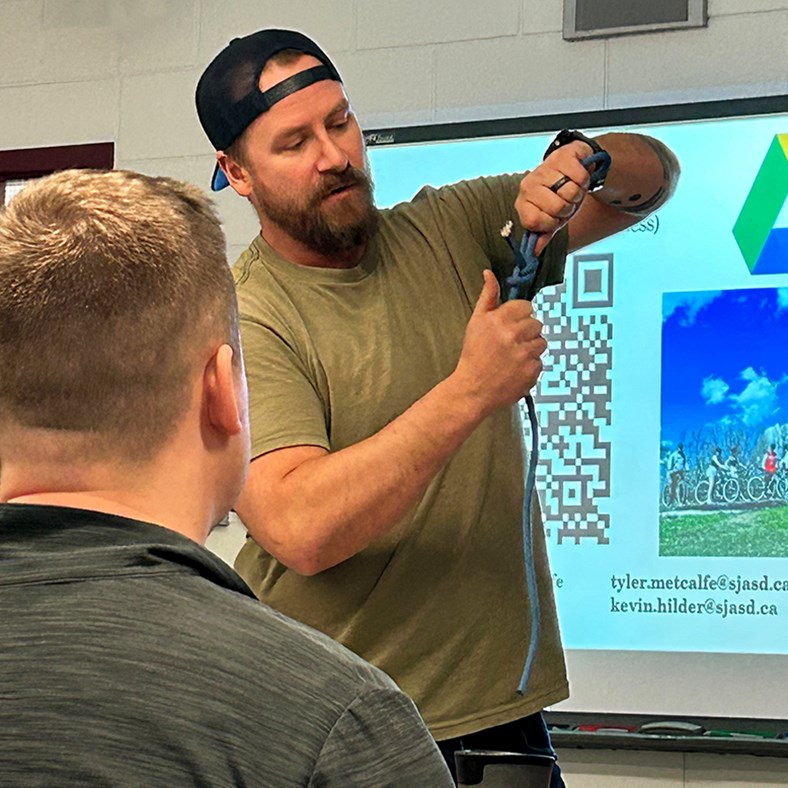
Pictured: Collège Sturgeon Heights Collegiate educator Kevin Hilder teaches attendees how to complete a knot.
At a conference session at Collège Sturgeon Heights Collegiate, four high school SJASD physical educators outlined the lesson's they've learned from teaching Sustainable Wilderness Management (PE31G) for the last several years.
The course covers wilderness skills ranging from camping and hiking, to fishing, to survival and water safety, while also helping students develop a connection and sense of responsibility to the land.
Collège Sturgeon Heights Collegiate educator Kevin Hilder ran attendees through a quick knot-tying exercise, which is critical to developing water and life safety skills. Students need to learn about 10 knots, especially the figure eight, clove hitch, and key on-key off knot.
“This is my favourite class," says Kevin, adding that he developed a love for the outdoors as a Phys Ed student in Calgary. “I love going outside and doing this."
Fellow Collège Sturgeon Heights Collegiate educator Tyler Metcalfe says the course helps students overcome fears that may have stopped them from trying new things, like handling fish, taking long hikes, confronting bugs and creature fears, and acting quickly in the event of a capsized boat or rescue situation.
“We try to get kids doing a million different things and maybe [they] find one or two of these things that [they] like doing and [they] keep doing after high school," he says.
Tyler takes students on a day hike to Hunt Lake, followed by a 16 to 18-kilometer round trip on the Mantario trail.
“Hunt Lake is important because [students] wear heavy back packs and it will give [us] an idea of who might have a problem," he explains, adding that shade and water breaks are frequent, and educators have the capacity to carry a student's pack if they need help.
Westwood Collegiate physical educator Brian Smichael has been teaching Sustainable Wilderness for 15 years. He takes students on an overnight canoe trip, a day trip, and several excursions to incorporate archery, shore fishing, climbing, geocaching, and cycling.
“It's my favourite course to teach," he says. “Once you get outside free of devices, you get to know the kids on a different level."
Brian says it's not usual for students that struggle in a classroom setting to excel outdoors, while students that do well in the classroom need more help.
Either way, he says it is great hands-on learning.
Dustin Bruce teaches Sustainable Wilderness at John Taylor Collegiate. The passionate outdoor enthusiast grew up fishing at West Hawk and Hunt lakes and says the majority of course assessment is practical.
“It keeps them accountable," he explains.
Dustin has students create their own fire starters and water filters. Students also learn to make fruit leathers and protein-based jerkies. To simulate raising a tent day or night, he has students set up tents outside during daylight hours, and in the dark in the gymnasium.
The culmination of his course is currently a three-day canoe trip.
“When you give kids the challenge, you will be amazed at what they can do," he explains.
SJASD teachers designed and launched Sustainable Wilderness Management about a decade and a half ago. A few hundred students a year currently take the course, which is offered at four SJASD high schools. All educators follow Division and MPASS safety regulations when planning day and overnight field trips.
Student Emotions in PE: Mixed Feelings
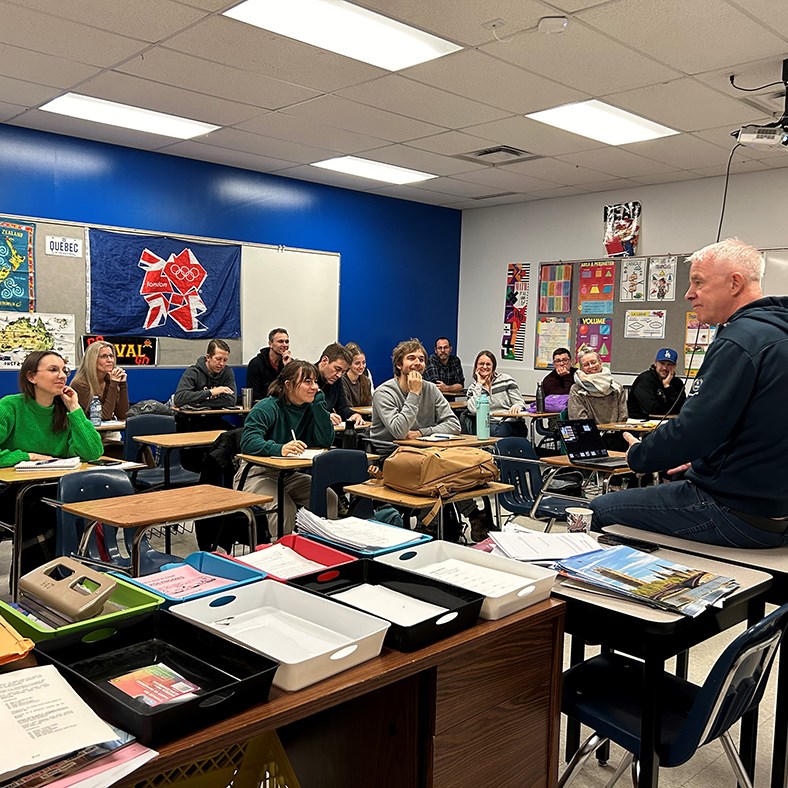
Pictured: U of M profession Dean Kriellaars speaks passionately about creating physical education experiences that will challenge all skill levels.
At a conference session at Collège Sturgeon Heights Collegiate, physical educators got a lesson in how emotions can help or hinder instilling the love of movement in physical education class.
U of M professor Dean Kriellaars presented his research on whether Grade 4/5 students had a positive (pride, enjoyment, relief) or negative (shame, anger, boredom) experience during PE class.
While about a third (37 per cent) of kids had mixed emotions, the vast majority (98 per cent) of students participating in a quality physical education class had a more positive than negative experience overall.
The key is developing a quality physical education program that provides a level of challenge for every level of ability, so that students have a chance to feel the pride of learning something new, instead of getting discouraged and becoming habituated to negative emotions.
“Pride and enjoyment can wipe out shame," he explains, adding that having a positive experience in gym can also improve self-esteem, competence and confidence.
Dean points out that research shows that many girls tend to “wallflower in movement" by Grade 6 and 7.
“If someone had a good experience in 4/5, it can help them have a positive movement experience in the future," he says.
Ray Algera is a physical educator and coach from Hanover School Division. He was struck by the need to prevent kids from dropping off in class, especially “the importance of keeping the girls engaged and having positive experiences in movement," he says.
Vital Renaud also teaches physical education in Hanover. “The big part that spoke to me was the mixed emotions. Struggle is very important," he says. “To have a positive experience, a little bit of both is okay."
Dean's research involved interviewing 145 students from five different schools in 14 different PE classes.
Fitness Club: They Work Out
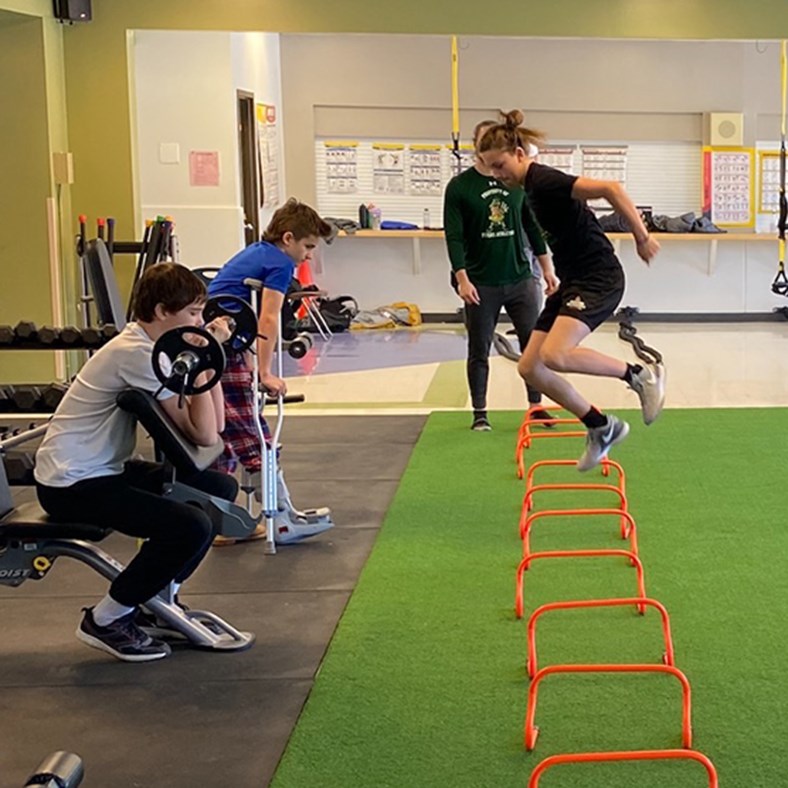

Pictured (top to bottom): Student demonstrates agility task during fitness training presentation; Winnipeg Blue Bomber Brian Cole drops in to Fitness Club in January 2024 to mentor students.
At a SEE session at Golden Gate Middle School, attendees learned about establishing a fitness club for 11- to 14-year-old students from physical educators Jordan Curtis and Ryan McGavock.
The school runs the programming out of an adapted school-based training facility that includes aerobic equipment, machine and free weights, TRX, battle ropes, a sled, an agility ladder, hurdles and more. The facility is available during PE time, and before and after school to any student that wants to join Fitness Club.
“When students arrived the first day of the club the energy was very high. There was lots of curiosity and wanting to try everything in the space," presenters explained to attendees. “The staff supervisors went around showing the students proper movements for the equipment and tried to remind students how sets and reps work and to work on Time Under Tension versus just going as fast as they could."
Fitness Club has been a hit, with the greatest participation coming from Grade 6 students.
Grade 6 student Emily enjoys the Club. “I like that it's very inclusive and I feel at home. Everyone is friendly and takes care of each other," she says.
William is in Grade 7. “I love the feeling of coming here and working out with friends. I wasn't really involved in school activities and [Principal] Kalynchuk mentioned the Club so I tried it and I loved it and now I come everyday," he says.
During the presentation, Jordan and Ryan had students demonstrate specific exercises while linking them to curricular outcomes for fitness and resistance training.
“It's great as supervisors seeing the kids realize they have more strength than they though," acknowledged the presenters. “Students continue to support and encourage each other, and it has created a comfortable environment with a wide range of personalities and abilities."
Supervisors provide students with an exercise log so they can work on a fitness plan and track their progress. They also set up small challenges to keep students interested and encourage them to improve on their own performance.
The facility is open to students and staff. Jordan and Ryan have been teaching physical education for the past seven years.

| Did you know that there are five focus areas for teaching in learning in SJASD's new Strategic Plan and conference sessions touched on many aspects of them, such as Success for Each Learner, Ma Mawi Anokiitaw Miinawaa, Mental Health and Wellbeing, and/or Supporting and Celebrating our Students? Learn more about our Strategic Plan here.
|